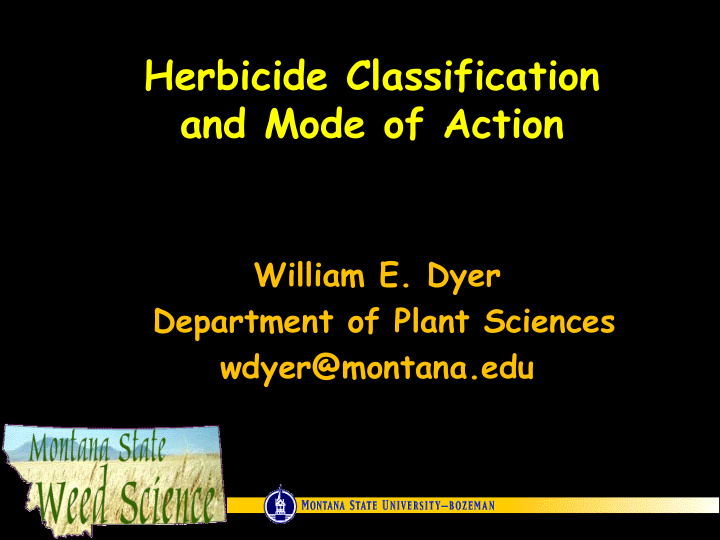



Herbicide Classification and Mode of Action William E. Dyer Department of Plant Sciences wdyer@montana.edu
Classification can be based on: 1. Chemical structure or family 2-choro-N-[[(4-methoxy-6-methyl-1,3,5- triazin-2-yl)amino]carbonyl]benzenesulfonamide 2. Cropping system or ecosystem 3. Mode of action = the plant process or pathway inhibited by the herbicide
Why Know Herbicide Modes of Action? • Better understanding of how herbicides perform • Improve herbicide performance • Diagnose herbicide injury • Prevent and manage herbicide resistance
Herbicide Mode of Action Movement Absorption Contact Site of Action Toxicity
Site of Absorption and Translocation Phloem Foliar Contact (Roundup) (Gramoxone) Rangeland herbicides Root Contact Xylem and Phloem (Treflan) (Banvel, Tordon) Xylem (Spike)
Herbicide Classification - Selectivity - • Selective: controls or suppresses one species of plant without seriously affecting the growth of another plant species – 2,4-D • Nonselective: control plants regardless of species – Roundup
Some Things to Remember…. • Photosynthesis (food) • Pigments (energy/light capture) • Respiration (energy) • Amino acids (proteins/growth) • Lipids (cell membranes) • Hormones (auxin and others)
Classification by Mode of Action Group 1) Lipid Biosynthesis Inhibitors 2) Amino Acid Biosynthesis Inhibitors 3) Cell Division Inhibitors 4) Synthetic Auxins 5,6,7) Photosynthesis Inhibitors 9) EPSP Synthase Inhibitor 14) Pigment Inhibitors 22) Membrane Disruptors 16,17,26) Unknown
Herbicide Mode of Action Groups Group 1: Lipid synthesis inhibitors (“grass killers”) Block ACCase enzyme Trade Names: Hoelon, Fusilade, Poast, Axial, Puma, Assure Symptoms Mechanism of resistance: Altered target site
Altered target site The normal situation A resistant enzyme
Herbicide Mode of Action Groups Group 2: Amino acid synthesis inhibitors; blocks ALS enzyme Trade names: Glean, Telar, Finesse, Muster, Permit, Ally, Escort, Canvas, Finesse, Accent, Basis, Beacon, Exceed, Peak, Matrix, Oust, Maverick, Harmony, Pinnacle, Cheyenne, Reliance, Amber, Rave, Upbeet, Arsenal, Assert, Lightning, Motive, Plateau, Pursuit, Raptor, Sceptor, Broadstrike, FirstRate, StrongArm, Python • Translocates to new growth in xylem and phloem • Plants stop growing shortly after application, but plant death may be slow (10+ days) Mechanism of Resistance: altered target site
ALS Inhibitor Symptoms Stunting Chlorosis of youngest tissue Chlorosis of youngest tissue Plateau Injury Symptoms
Herbicide Mode of Action Groups Group 4: Synthetic auxins Overwhelm natural auxin pathways Trade names: 2,4-D, MCPA, Banvel, Clarity, Milestone, Perspective, Tordon, Stinger, Curtail, Transline, Starane, Garlon, Remedy, Renovate, Paramount, Drive Translocates in both xylem and phloem • Symptoms most obvious in new growth • Selectively kill broadleaf plants • Soil residue varies from a few days to several years • Mechanism of Resistance: ???
Synthetic Auxin Symptoms Phenoxy drift on tomato Ohio State University Phenoxy on Red Oak University of Illinois extension Pyrdine on tomato Benzoic acid on soybean Washington State University Photo: HMOA and Crop Injury Symptoms Extension Univ. of Minnesota Extension
Synthetic Auxin Symptoms Twisting needles due to drift of triclopyr
Herbicide Mode of Action Groups Groups 5,6,7: Photosystem II inhibitors Block photosynthesis Trade names: Aatrex, Princep, Simazine, Velpar, Sencor, Hyvar X, Sinbar, Basagran, Buctril, Bronate, Karmex, Direx, Lorox, Linex, Spike • Injures old growth first, moves only upward in xylem • Injury symptoms: yellowing (chlorosis) of leaf tissue followed by death (necrosis) of the tissue Mechanism of Resistance: altered target site
Injury from PSII herbicide Interveinal, tip, and margin chlorosis Interveinal chlorosis Leaves necrotic
Consequences of photosynthetic inhibition
Herbicide Mode of Action Groups Group 9: Glycines (glyphosate) Inhibit amino acid biosynthesis Trade names: Roundup, Gallup, Kleenup, Landmaster, Pondmaster, Ranger, Rodeo, Touchdown • Translocates to new growth in xylem and phloem • Plants stop growing shortly after application, but plant death may be slow (10+ days) Mechanism of Resistance: reduced translocation, gene amplification
Glyphosate Injury Symptoms shortened chlorosis internodes stem proliferation
Herbicide Mode of Action Groups Group 22: Bipyridiliums (paraquat) Divert electrons from photosynthesis Trade names: Reglone, Gramoxone, Scythe, many others Symptoms Mechanism of Resistance: enhanced detoxification
Other Herbicide Mode of Action Families Group 3: Microtubule assembly inhibitors Group 14: Protox inhibitors Group 15: Long chain fatty acid synthesis inhibitors Groups 16,17,26: Unknown
Why aren’t there any new herbicides? • All herbicides now on the market were discovered by accident. • Half of all current herbicides inhibit one of only three target enzymes. Banvel-resistant kochia • New ‘target- based’ technologies MAY lead to new herbicides. R S R
More Information? http://msuextension.org/publications/Ag andNaturalResources/MT200506AG .pdf
Recommend
More recommend